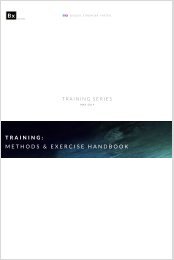Create successful ePaper yourself
Turn your PDF publications into a flip-book with our unique Google optimized e-Paper software.
HTKSPORT<br />
Sprinting, for example, is typically a combination of MAG and SPD. The difference in<br />
the relative contributions of each type of input to any given activity is basically placing<br />
the activity at a certain point along the SUS-MAG-RATE continuum (see below).<br />
Activities that are generally relatively slow but require extended applications of force<br />
will be closest to the DUR input, while activities that require the most speed, and<br />
hence neural transmission rate will be closest to the RATE input. Those activities<br />
requiring the greatest degree of motor unit recruitment, force and muscular tension<br />
will also require maximal neural activity and therefore be closest to the MAG input. As<br />
has been noted, jumping and sprinting generally create the largest force output. This<br />
is because they utilise both contractile and stored elastic energy (reactive strength).<br />
What this shows is that maximal force output is a combination of strength and speed<br />
of movement. This is what is typically defined as ‘power’ (Power = Force x Velocity). It<br />
also explains why the most powerful athletes are not always the most traditionally<br />
strong athletes; the reliance of the elastic/reactive strength component is only<br />
possible through fast, dynamic movements, and therefore explains why the most<br />
powerful athletes are usually not the strongest athletes in the squat or deadlift.<br />
It should start to become clear as to the type of movements one can employ in<br />
training to train the various neuro-muscular inputs. DUR and RATE are quite self<br />
explanatory - DUR is generally explained by either max single efforts that require<br />
sustained muscle contraction, or extended bouts of contraction. RATE is associated<br />
with contracting muscles as quickly as possible. RATE, therefore, is rarely associated<br />
with significant resistance (but note that one way to increase the speed of a<br />
contraction is to load a speed movement, thereby increasing the activation and speed<br />
of the unloaded movement); any resistance used should elicit a potentiation training<br />
effect, rather than a strength (or other) effect that slows the movement.<br />
MAG training, on the other hand, in the absence of suitable measuring technology, is<br />
more difficult to recognise externally. MAG input is hard to describe but often<br />
recognisable to the athlete by the ‘feel’ of the exercise. Although some exercises like<br />
sprinting, jumping and some other max force/speed exercises are easily classified as<br />
MAG by their very nature, it is more difficult to explain how to train MAG work with<br />
traditional training methods. A common guide for most athletes is that MAG input will<br />
be stimulated at resistance loads between 51% and 75% of the athlete’s AW 1 rep<br />
max for that exercise.<br />
11<br />
JUNE 2018 | ISSUE 01




